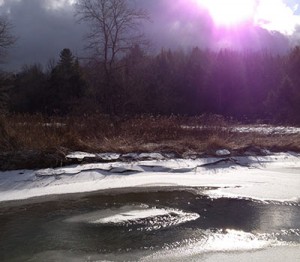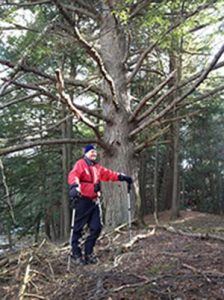
|
As children, both Peter and Sandy Dietrich spent a great deal of time outside, exploring nature and hiking in the woods. When they first came to Vermont four decades ago, it was the couple’s passion for birds that helped them decide on a 30-acre parcel close to the village of Shelburne. Their property included nearly a mile of frontage on the La Platte River just above the waterfalls.
The La Platte River valley, with a natural variety of habitats perfect for the ardent birders, was just downslope from their house. All three daughters raised in their house embraced having nature close to home. And the local black bear loved their passion for feeding the birds.
Though they would travel on birding trips far away, they would still “spend hours watching birds right from our property, including the warblers and owls along the river,” reflected Peter.
In talking with the Lake Champlain Land Trust last year, they realized that their bird habitat could also protect Lake Champlain. The Dietrichs were interested to find out about our efforts to protect and restore the Upper La Platte River Natural Area—the property adjacent to their family land.
As part of a growing effort by the land trust and community members to help restore area waterways for water quality, and reduce the impacts of flooding, the Dietrichs generously conserved the 20-acre portion of their land along the La Platte River.

Like the 65-acre natural area upstream, their stretch of the La Platte River holds the state endangered Stonecat fish. It also contains former floodplain forests that can be restored as a water quality filter for Lake Champlain. (The La Platte River flows directly into Shelburne Bay which hosts the intake for the drinking water used by 60,000 people in the local water district.)
“We are delighted that we can help improve water quality by conserving our land as well as working with the land trust in the future to help restore the floodplain forest,” Peter Dietrich noted.
The Dietrichs included the possibility of constructing a wildlife and bird watching observation blind within their conservation plan with the hope that it will be used by area schools.
Once the land trust secures funding for the observation blind, a connector trail will be built to connect the existing Upper La Platte River Natural Area trails and parking area to the new trail. The Upper La Platte Natural Area, opened in 2011, offers wonderful walking trails, wildlife viewing, and the perfect location for environmental education.
“When we were young, nature was something you just did,” reflected Peter. “Now, with all the electronics young people are focused on, it’s really important for schools and youth groups to bring kids into nature. It also brings us great joy to share this special place with the rest of the community. If our land becomes a place of learning for schoolchildren and inspires in them a love of nature, then that is more than we could ever expect.”

